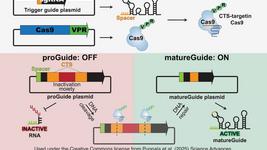CMN Weekly (13 January 2023) - Your Weekly CRISPR Medicine News
By: Gorm Palmgren - Jan. 13, 2023
Top picks
- Eric Olson and colleagues demonstrate how CRISPR gene editing reagents can be injected into mice soon after ischemia exposure, thereby allowing them to recover from severe heart damage without ischemia-reperfusion injury. The scientists used CRISPR-Cas9 adenine base editing of the calcium calmodulin-dependent protein kinase IIδ (CaMKIIδ) gene to eliminate the protein's oxidative activation sites. The results suggest that it may not be too late to intervene after a heart attack.
- Editas Medicine announces that it will discontinue internal investments in EDIT-101 for Leber Congenital Amaurosis 10 (LCA10) and other programs on inherited retinal diseases - including EDIT-103 for rhodopsin-associated autosomal dominant retinitis pigmentosa. The move is part of a strategic reprioritisation to narrow the R&D efforts to focus on hemoglobinopathies and in vivo discovery to pursue and develop programs the company believes have maximum probabilities of technical, regulatory, and commercial success. As a result, resources will be allocated towards EDIT-301 for treating severe sickle cell disease and transfusion-dependent beta-thalassemia. In addition, investments in the company's wholly-owned multiplexed edited induced pluripotent stem cell (iPSC) derived natural killer (iNK) cell programs, including EDIT-202 for solid tumours, will also be discontinued.
Research
- Recent Nobel Prize laureate Svante Pääbo is co-authoring a paper that describes a method to detect unintended on-target effects in CRISPR genome editing by DNA donors carrying diagnostic substitutions. The so-called ‘sequence-ascertained favourable editing' (SAFE) donor approach allows unintended events affecting editing target sites to be easily detected when the target site is sequenced to determine the genome editing outcome in cellular clones. The authors analysed more than 850 human embryonic stem cell clones edited with 'SAFE' donors and detected all copy number changes and almost all clones with gene conversion.
- Polymerase-free targeted long-read sequencing is superior to PCR-based nanopore sequencing for capturing CRISPR editing and AAV integration outcomes, according to work by scientists in the US. They compared the technique after in vivo single- and dual-gRNA AAV-CRISPR editing of human ATXN2 in transgenic mouse models of spinocerebellar ataxia type 2 (SCA2). PCR-based nanopore sequencing showed a bias for partial AAV fragments and inverted terminal repeats (ITRs) and failed to detect full-length AAV. At the same time, the polymerase-free method found AAV integration, 1-2% of which contained the entire AAV genome, and greater than 150 kb deletions at target loci and rearrangements of the transgenic allele (1%).
- Researchers at Beam Therapeutics have generated and characterised new cytosine base editors (CBEs) that rely on engineered variants of the tRNA deaminase TadA (CBE-T) and enable high on-target C·G to T·A across a sequence-diverse set of genomic loci. Moreover, the authors report on new cytosine and adenine base editors (CABEs) catalysing both A-to-I and C-to-U editing (CABE-Ts).
- Researchers in China have developed an adenine transversion base editor, AYBE, for A-to-C and A-to-T transversion editing in mammalian cells. This was achieved by fusing an adenine base editor (ABE) with hypoxanthine excision protein N-methylpurine DNA glycosylase (MPG). Further engineering of the AYBE enabled targeted editing at genomic loci with transversion editing activity up to 72% for A-to-C or A-to-T editing.
- In a patient-derived in vitro muscle cell model of Limb-Girdle Muscular Dystrophy type D2, Spanish scientists have used CRISPR-Cas9 to reverse the pathological phenotype in edited cells. The ultrarare disease is caused by a single nucleotide deletion in the stop codon of the nuclear import receptor transportin-3 (TNPO3) gene leading to the extension of the wild-type protein. Correction of the TNPO3 mutation via CRISPR-Cas9 editing caused a significant reversion of the pathological phenotypes in edited cells, including a complete absence of the mutant TNPO3 protein.
Industry
- German company BRAIN Biotech is founding a new sister company, Akribion Genomics, focusing on genome-editing therapeutic applications, including applications in oncology. The new brand name will exploit the novel mode of action of the nuclease G-dase E™ (previously termed “BEC”) that allows for targeted cell disruption based on RNA biomarkers.
- In a new extended strategic partnership, Vertex Pharmaceuticals will receive rights to Arbor Biotechnologies' novel precision gene editing technologies using reverse transcriptase for developing in vivo genetic medicines. Under the terms of the agreement, Arbor will receive payments based on achieved milestones, while Vertex will pay tiered royalties on future net sales of any potential products.
- Tessera Therapeutics has demonstrated proof of concept in non-human primates of its RNA and DNA Gene Writing platforms. The technologies can write into or rewrite the genome based upon an RNA or DNA template using retrotransposon biochemistry and recombinase or transposase element biochemistry, respectively.
- Fate Therapeutics has declined a proposal from Janssen Biotech to continue collaboration on two product candidates targeting high-value, clinically-validated haematology antigens that were set to enter clinical development in 2023. The company will instead focus on its second-generation CD19-targeted CAR NK cell program. It incorporates CD38 knockout and can be effectively combined with B cell-targeted monoclonal antibody therapy, including those targeting CD20 and CD38, to direct a multi-antigen attack on target cells.
- Precision BioSciences has received supportive Type C feedback from the FDA on its CMC processes and analytical methods for azer-cel (azercabtagene zapreleucel). Azer-cel is an allogeneic, CD19-directed cellular therapy derived from healthy donor cells. It is created with a single-step ARCUS gene editing process that minimises translocations and off-target editing.
- Beam Therapeutics reports significant momentum across its clinical-stage candidates BEAM-101 and BEAM-201, targeting sickle cell disease and relapsed/refractory T-cell acute lymphoblastic leukaemia (T-ALL)/T-cell lymphoblastic lymphoma (T-LL), respectively. In addition, two other programs - BEAM-301 and BEAM-302 targeting liver diseases with lipid nanoparticle (LNP) delivery - are moving toward clinical trials.
- Asklepios BioPharmaceutical (AskBio) - a wholly owned and independently operated subsidiary of Bayer AG - has signed a multi-year research collaboration and option agreement with ReCode Therapeutics. Under the agreement, the companies will work together to discover precision genetic medicines by developing a novel platform for full gene insertion by single vector delivery of gene editing and DNA cargoes. In addition, the collaboration will exploit ReCode’s selective organ targeting (SORT) lipid nanoparticle (LNP) platform that enables precise delivery to target organs and cells beyond the liver.
- Intellia Therapeutics announces that the UK Medicines and Healthcare products Regulatory Agency (MHRA) has awarded the Innovation Passport for NTLA-2002, an in vivo genome editing candidate being developed for the treatment of hereditary angioedema (HAE). The Innovation Passport is the point of entry into the UK's Innovative Licensing and Access Pathway (ILAP), which is designed to accelerate time to market and facilitate patient access to innovative medicines.
Detection
- Scientists in China have developed a new accurate, sensitive, and rapid method to detect the bacterial pathogen Pseudomonas aeruginosa. The technique uses CRISPR-Cas12b with one fluid-handling step in one tube and achieves 100% inclusivity and exclusivity among 48 strains, including 15 P. aeruginosa clinical isolates and 33 non-P. aeruginosa strains.
More
- Three Ways CRISPR Is Making Animal Research Models More Predictive. In this write-up on Genetic Engineering & Biotechnology News (GEN), Lieke Geerts at Charles River Laboratories describes how CRISPR-based animal models can help developers improve target engagement, human efficacy, and safety.
News from CRISPR Medicine News
- Thursday, we summarised the latest updates from ongoing gene-editing clinical trials. These included data from Editas Medicine's ongoing RUBY trial for EDIT-301 in severe sickle cell disease and updates about Caribou Biosciences' PD-1 knockout CAR-T cell therapeutic candidate for relapsed or refractory large B cell lymphoma and non-Hodgkin lymphoma.
To get more of the CRISPR Medicine News delivered to your inbox, sign up to the free weekly CMN Newsletter here.
Tags
CLINICAL TRIALS
IND Enabling
Phase I
Phase II
Phase III
Gastric Cancer and Colorectal Cancer, CRC, (NCT07166263)
Sponsors:
Base Therapeutics (Shanghai) Co., Ltd.
Sponsors:
Base Therapeutics (Shanghai) Co., Ltd.
IND Enabling
Phase I
Phase II
Phase III
Relapsed or Refractory Acute Myeloid Leukemia, AML, (NCT06541444)
Sponsors:
Base Therapeutics (Shanghai) Co., Ltd.
Sponsors:
Base Therapeutics (Shanghai) Co., Ltd.
IND Enabling
Phase I
Phase II
Phase III







